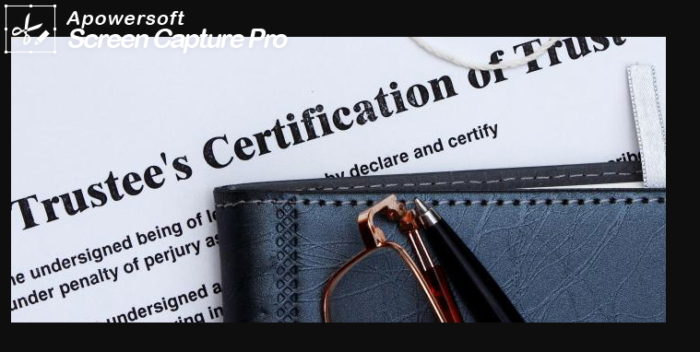Certificate of Trust is an outline of imperative information on the subject of your trust.
This certificate is also called a “family” or “revocable” or “inter vivos” trust, and it is used to want to ensure that every asset acquired by the trustee is within the trust’s name.
Furthermore, a certificate of trust is also used at the time of opening a new bank account because it is a requirement from the bank and brokerage.
In addition, a certificate of trust is a requisite when buying real state.
Furthermore, a living trust is created while you are still alive contrary to a trust fund formed by someone else after you’ve died.
The trust is a preparation that provides having legal title over whichever property you are holding and protect for your receiver after your death.
In order to have a certificate of trust, you will have to name a “trustee” or “trustees”, this is the beneficiaries that are going to be in control of the property on behalf of your planned beneficiary.
One of its benefices is this type of trust will decrease estate taxes, avoid probate, and grant management for your property.
Steps to obtain a living trust:
Establish the fundamentals of the certificate of trust

- Make a decision if the living trust is will be shared or individual. For example, a shared trust is one that includes:
- You
- Your spouse
- A partner
- Come to a decision to designate who runs your living trust. You can be in charge of the trust or choose someone to be the trustee. However, be careful to pick an heir trustee to administer the property once you’ve died.
- Establish the property you want to incorporate in your living trust such as:
- Bonds
- Stocks
- Real estate
- Select the beneficiaries you want to leave your belongings in your living trust. It could be:
- Friends
- Family members
- Charities
- As well, it is import to add on the lost, contingent beneficiaries, this could only become heir, if the person designated in first places, dies before you do.
Create the certificate of trust

- Look for an attorney to draw up the paperwork
- In addition, you can go online and use a legal website, to search for a copy of a recorded living trust, or forms on a CD to make the living trust
- Sign the living trust in front of a notary public to notarize it. In case your spouse or partner made the trust together, you both need to sign the certification. If one has died, the surviving part can make a certification.
- Record the trust with your local county office
Transfer all the property titles into the trust
Doing this procedure will make your trust effective.
- Organize a new deed for all the real property that will go in the trust. This deed must include the name of the trustee followed by a comma and then the label “trustee of the (your name) Revocable Living Trust” and the date of making the document.
- Attend the county records office and transfer the titles into the trust. Have in mind there are fees to be paid for, so be prepared.
- Guard your certificate of trust in a place where you can access it any time
Who can sign the certificate?
Only the creator of the trust referred to as the “Grantor” or “Trustor” or the lawyer for the trust can sign the certificate of trust. The trustee who is not also a grantor or trustor is not competent, neither needs to sign the certificate.
Why will you need to update your certificate of trust?
If it comes to an occasion when you need to update your certificate of trust, for example, if one of your trustees dies or if the trust is buying or selling real estate or if your certificate of trust hasn’t be updated in a while, have in mind that the certificate only shows the current status of your trust.
But, it is not a way to change or update the trust itself.
Use a Certification in lieu of your trust document

If you don’t want to prove your trust document, in most cases, for example, when buying real state, you can use a shorter version of it, called a certification.
The certificate, abstract or memorandum of trust, the name will depend on the law of the state you live in, and it is used to provide institutions the information they need but allows you keep some key provisions private, it gives you some privacy.
Likewise, you don’t have to reveal the names of the beneficiaries to whom you’re leaving trust property.
The certification is almost unanimously accepted in place of an entire trust document.
In some states have laws stating that if a certification of trust includes certain information, institutions must accept it in lieu of the entire trust document.
Furthermore, California law, for example, dictates that someone or institution who refuses to recognize a valid certification and demands to see the entire trust document may be legally responsible for any monetary loss suffered by the trust grantor.
Check the state law online https://www.nolo.com/technical-support-main/nolo-living-trust-making-a-certification-or-abstract-of-trust.html
Advantages of a Certificate
- A certificate of trust does not incorporate certain information that you might not want to share
- It doesn’t name your beneficiaries or trustees
- The certificate does not include what the beneficiaries are entitled to become heir to from you or when they might obtain it.
- This allows both parties (grantor and trustee) to do commerce without giving information that you may don’t want to disclose

